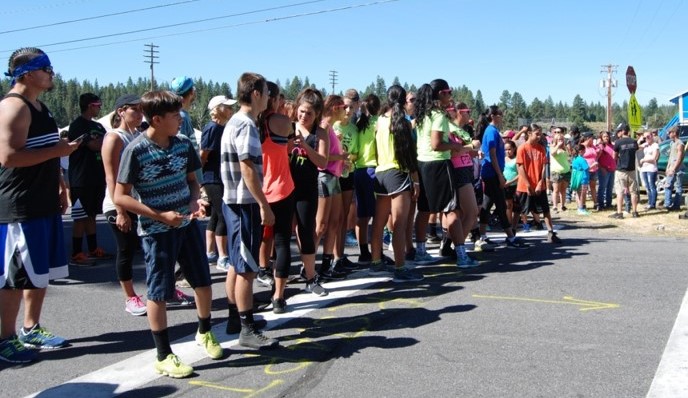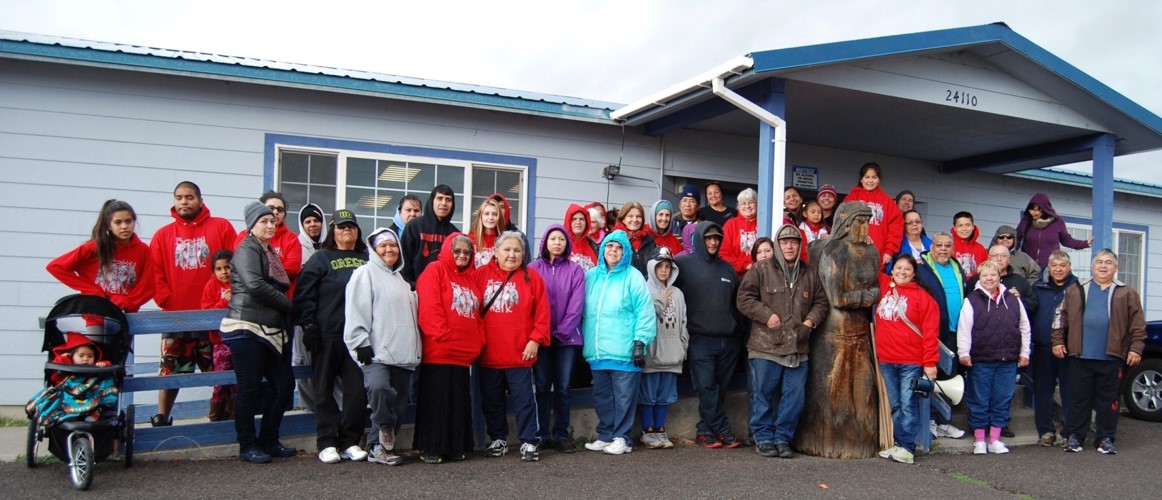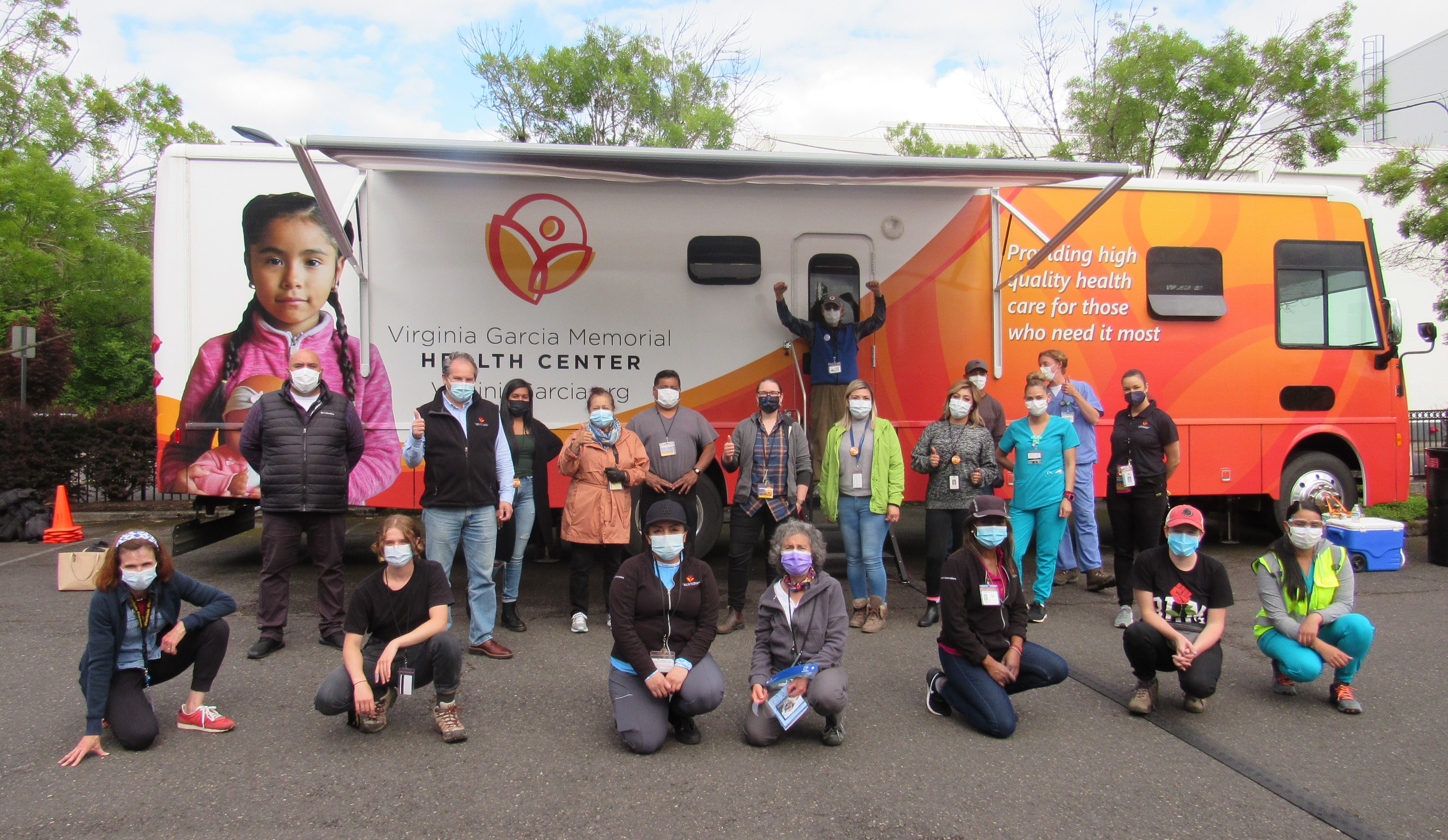Grantee Stories
Learn about a few Community Partnership Program funded projects
The work accomplished with Community Partnership Program support spans Oregon, helping communities with funding and resources to sustainably work toward solving local cancer-related needs. The following profiles are a sampling of grantees and projects that have been funded through the program.
This video features five grantees: Asian Health & Service Center (Portland), Chelsea's Closet (Tigard), GO ASAP - Get Outside After School Activity Program (La Grande), Southern Oregon Friends of Hospice / Celia's House (Medford), and Thadd's Place (Grant County).
Tiered Grants
Tier 1 | Crook County Health Department (Crook County)
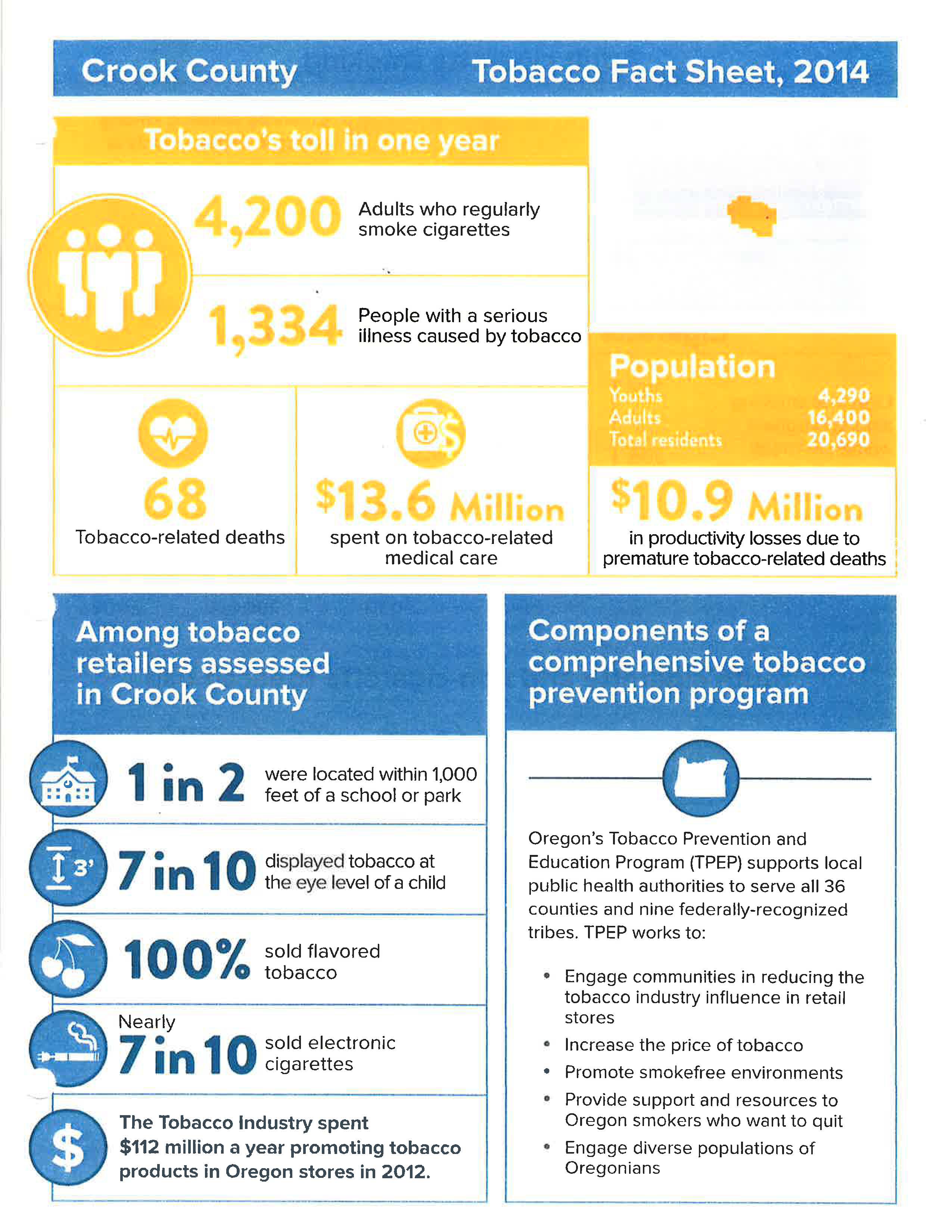
Crook County holds one of the highest rates of adult and adolescent tobacco usages in Oregon. With local providers expressing concerns over the community's lack of resources dedicated to tobacco cessation, the Crook County Health Department applied for and received a Tier 1 grant from the Community Partnership Program to address this crucial cancer prevention need. This Tier 1 grant gave the Crook County Health Department the opportunity to create a workgroup that would engage with a variety of stakeholders including providers, patients and coordinated care organizations (CCOs). From this, next steps were to determine the exact need within the community and to identify possible solutions for creating local cessation resources.
By bringing together providers and CCO representatives, questions and concerns about how to tackle this issue were shared freely. The workgroup collaborated to create, distribute, and collect a patient survey that was distributed to clinics throughout the county. Data from the survey was used to answer workgroup questions and inform their decision making process of how to accomplish the common goal of providing effective local tobacco cessation support.
In total, 309 survey responses were gathered from patients at St. Charles Medical Clinic, Mosaic Medical, Crook County Health Department, Cascade Direct Care, and Lutheran Community Services Northwest. 286 of those responses were from patients 18 years or older. 114 patients responded that they use tobacco and 61 (53.5%) of those patients reported that they want to quit. When asked what kinds of support resources patients were most interested in using to help them quit, the top three resources were hypnosis, prescription medication, and self-help quitting guides. Responses also generated a list of potential barriers patients anticipate that would prevent them from utilizing those resources. The top three barriers identified were class fees, time, and transportation.
Now armed with both data and stakeholder support, the Crook County Health Department hopes to take this information and move forward with a future implementation of tobacco cessation resources for interested patients.
Tier 2 | Hood River County Prevention Department (Hood River County)
Building a community's ability to address tobacco use sometimes starts with a shift in improving the clinical process.
The Hood River County Prevention Department's Tier 2 Community Partnership Program grant aimed to engage and train primary care providers, clinic staff, and community health workers in best-practice/evidence-based interventions that could be incorporated into their practices and utilize with tobacco using patients enrolled in the Oregon Health Plan. The project's ultimate goal was to increase the number of OHP members quitting tobacco in Hood River and Wasco counties who use tobacco.
Two tactics were used with OHP patients: motivational interviewing and revamping the referral process when a provider would see a tobacco using patient. After interviewing clinical staff about the effectiveness of the current system and dissecting the system itself, a new workflow paired with a "readiness ruler" was created to better refer tobacco users to resources. If a patient matched with five or more qualifiers on the "readiness ruler," a patient would be asked if they were interested in quitting. If so, a referral to a behavioral health specialist would occur.
Patients were also referred to the Oregon Tobacco Quit Line. Since instating the project, the Quit Line experienced a 395% increase in traffic. Consistent cessation messaging was shared with providers and patients through bookmarks and magnets.
Throughout the duration of the project, as various obstacles were identified, they were noted then paired with a plan to fix the discovered issue. The discovery of these obstacles helped simplify the referral and treatment processes for both OHP patients and clinic staff. Input also was gathered successfully through collaborations with clinic providers, community health workers and Medicaid stakeholders about how clinics could help patients quit tobacco.
Tier 2 & 3 | Uriel Medical Foundation | Deschutes County
Developed the SHADE curriculum (Sun Hat Awareness Distribution and Education) for elementary school students.
In Central Oregon, sunny days are all-season and sun safety is an important message for people of all ages. To the surprise of most, Oregon has the 4th highest rate of melanoma in the country and Deschutes County has the highest incidence of melanoma in the state. One in five Americans will develop skin cancer in their lifetime. Additionally, approximately 90 percent of non-melanoma skin cancers are associated with exposure to ultraviolet (UV) radiation from the sun. A person receives nearly a quarter of their lifetime UV exposure by age 18 and the hours of the day with the strongest UV radiation occur during school hours. As exposure to UV radiation is a risk factor that can be most easily minimized, sun safety education for children, their parents, and their teachers is necessary for long-term health. This need is heightened in the Central Oregon High Desert, where sunny days number more than 300, and the high elevation and outdoor enthusiast lifestyles inherently increase sun exposure.
Through a Tier 2 grant during the first award cycle, the Uriel Medical Foundation partnered with the Bend Science Station to develop an elementary school science curriculum that combined the need for sun safety education and teachers' need for an exciting science curriculum that meets state standards. Through the grant, the SHADE curriculum was developed: Sun Hat Awareness Distribution and Education, a hands-on, inquiry-based science curriculum for elementary school students. SHADE uses science and hands-on experiments to teach sun awareness and the importance of protecting skin while enjoying the great outdoors. The science curriculum is paired with a comprehensive two-day teacher workshop at the Bend Science Station and focuses on the sun, UV radiation, and sun safety measures for skin cancer prevention. An instrumental piece of the curriculum is the availability of an "inquiry module," available free of charge to schools, which includes numerous pieces of science equipment for the students to use in the classrooms. The unit concludes with sun hat distribution to participating students, teachers and faculty for use during all school recesses and outdoor activities.
The curriculum, which is typically implemented over a 3 to 4 week period, begins with an understanding of the sun, building through hands-on projects that demonstrate the electromagnetic spectrum and the presence of invisible waves with fun projects that highlight x-rays, ultraviolet light, visible light, infrared, microwaves and radio waves. The students are then provided microscopes and slides with plant cells and animal cells. The kids brainstorm the differences in plant vs. human cells, including discussions of cell shapes and cell walls, which leads them to a discussion on damage to DNA. The unit concludes with an opportunity for the kids to use UV sensors and hand-held computers to measure and graph the strength differentiation of UV rays in the sun, shade and under a hat or sunscreen. By building the upon the prior weeks' lessons, students process the interconnectedness of the curriculum units and make hypotheses applying the knowledge they've gained through their projects.
In the pilot year during the Tier 2 program, the curriculum moved from idea to implementation and was taught in four Central Oregon schools: approximately 360 students in 14 classrooms. Sunhat counts indicated a significant increase in sunhat use at recess - from zero before the program, to 152 near the end of the school year.
Based on the enthusiasm of teachers and students, the Uriel Medical Foundation applied for and received a Tier 3 grant for evaluation and expansion of the program. During the 2016-2017 school year, two to three additional schools in the Bend area are being added to the program and each of the implementation sites are paired with a comparison site for program evaluation. The Tier 3 grant is providing the opportunity to reach more students (up to 550) and teachers while also evaluating the efficacy of the program as an evidence-based approach through before and after sunhat counts, parent surveys and teacher surveys.
Tiers 2 & 3 | Zenger Farm | Multnomah County
Consuming a diet rich in fresh fruits and vegetables can prevent or reduce the risk of developing cancer and other chronic health conditions. For many in area communities, the problem starts with a lack of access to fresh produce. Without access and education around fresh produce to populations most at risk for poor nutrition, one's health outcomes can suffer.
Zenger Farm, in cooperation with several community partners, put together a prescription community supported agriculture (CSA) vegetable program for families most at risk for poor nutrition. Participants receive a weekly vegetable share from local farms at their neighborhood clinic as well as cooking classes.
In 2015, the project began with 25 families being served by 1 clinic and 1 farm. The project expanded in 2016 to 100 families, four clinics and four farms. Each week, families would pick up their CSA share of vegetables from their assigned farmer. Participants and farmers would get to know each other and would share information and knowledge related to the vegetable being delivered that week.
Participants were also able to interact with other families in circumstances similar to their own when picking up their weekly CSA delivery. For many participants, this interaction not only provided a welcomed sense of shared community, but for some, it was their only interaction each week that was outside of the home.
Post-project evaluation data demonstrated statistically significant improvements in several indictors relevant to cancer and chronic disease prevention. Highlights include:
- An increase from 11% to 52% of CSA participants who reported eating the recommended amount (>2 cups a day) of vegetables,
- 100% of participants reporting eating a greater variety of vegetables due to the CSA program,
- 95% of participants learned new ways to cook and prepare vegetables,
- 80% of participants reported better overall health,
- 95% of participants discovered enjoying consuming vegetables they had previously disliked.
For 2017, Zenger Farm hopes to expand the program further and will target a new demographic: pregnant women eligible for the Women, Infants, and Children (WIC) nutrition program.
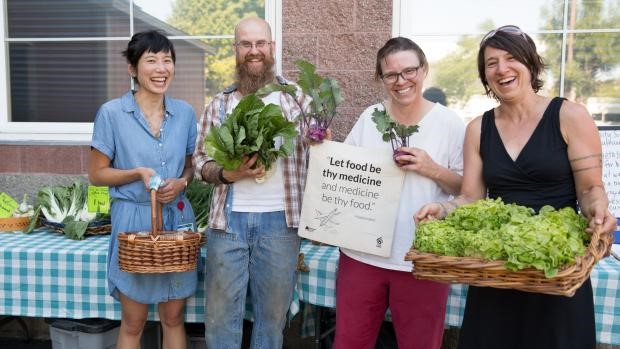
Tier 3 | Eastern Oregon University | Union and Baker Counties
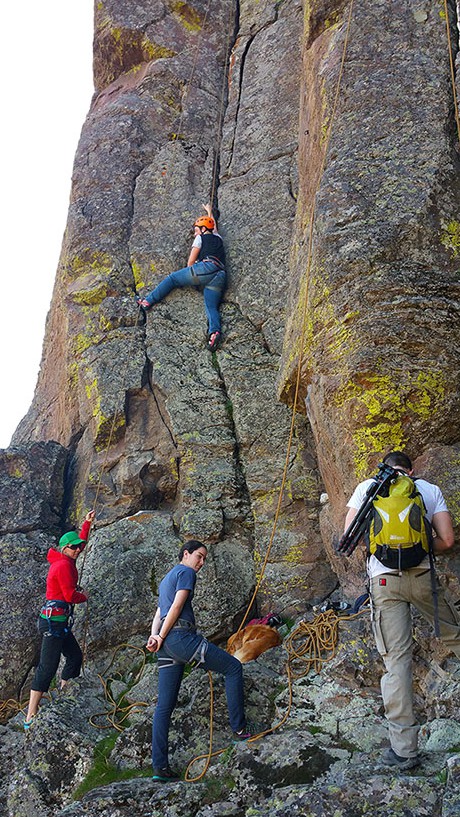
Adolescence is a key time to start healthy habits that can reduce the chance of cancer and other chronic disease. Unfortunately, in many rural counties, this can be a challenge. Previous studies have found that the higher cancer mortality rate in rural communities has been associated with higher rates of smoking and physical inactivity. Adolescents have an increased likelihood of adopting these risky behaviors during after-school hours. In addition, childhood obesity is associated with an increased risk for many adult onset cancers.
Studies have found time spent outdoors after school was positively associated with greater physical activity and fitness, and negatively associated with sedentary behavior. In rural areas like Union County, there are multiple barriers preventing this such as a lack of physical activities for adolescents not involved in sports and an under-utilization of the rich, outdoor environment of Eastern Oregon.
Eastern Oregon University's Tier 3 grant lead to the establishment of GO-ASAP (Get Outside After School Activity Program), a 20 week pilot program targeting at-risk 7th and 8th graders in La Grande. The program's central long-term goal was to reduce cancer risk behaviors (physical inactivity and risky behavior) through education and accessible outdoor activities.
Over the course of five months, students would meet twice per week. The first class would include a cancer prevention lecture paired with an outdoor skills activity such as using snowshoes or a stand-up paddleboard. The second class would go outside in the community and implement the skills learned earlier that week. Students learned how to ski, mountain bike, hike, geocache and use survival skills among other activities. Three weekend trips were also included along with a three day backpacking trip at program's end.
At GO-ASAP's conclusion, participants experienced a decrease in sedentary time paired with an increase in vigorous exercise and an increase in self-reported physical exercise. This increase in physical activity correlated with increased self-confidence and efficacy with participants—a finding that was backed up in subsequent focus groups featuring the parents of the participants. Knowledge about cancer and establishing healthy habits also increased for all participants.
In December 2016, the program was refunded for another Tier 3 grant for expansion into Baker County. Eight of the previous at-risk teenage participants will be returning for the next iteration of the program—this time, as student leaders.
is supported by the OHSU Knight Cancer Institute to encourage kids to play outside, to teach them lifestyle physical activity, and to engage in healthy behaviors while having fun.
Learn more: https://www.revcenter.org/go-asap
Video courtesy of Bobby Cuadra – A Twilight Dawn Films.
Tier 3 | Upstream Public Health | Multnomah County
Deployed a health equity impact assessment evaluating the effects of a tobacco retail policy within Multnomah County communities
Tobacco retail licensing has been shown to be a proven solution to could help reduce health inequities caused by tobacco, particularly in neighborhoods with low-income populations and people of color disproportionately targeted by tobacco marketing. Thanks to the efforts of Upstream Public Health, Multnomah County is now one of the few counties in Oregon enforcing this type of system.
Oregon has the highest rate of illegal sales of tobacco to minors, according to the Oregon Health Authority. In Multnomah County, one in four retailers illegally sold tobacco products to minors in 2014. Upstream's data indicated that a strong, impartial tobacco retail licensing policy would be effective in limiting youth access to tobacco and preventing future health inequities.
Tobacco companies have historically targeted residents in vulnerable neighborhoods by using advertising methods and promotions specifically intended for communities of color and low-income communities –contributing to persistent inequities in tobacco use. For example, more than 1 in 3 people with earnings less than $15,000 a year still smoke. More than 1 in 3 Native American and African American residents are smokers. Residents with mental health and substance use challenges are nearly twice as likely to smoke. Tobacco use contributes to health inequities in heart disease rates, stroke, type 2 diabetes, and various types of cancer. It exacerbates lung disease, cardiovascular and respiratory illness, and can increase the risk of reproductive and developmental health outcomes like premature births and low birth weights.
As part of their Community Partnership Program grant, Upstream Public Health received funding for a Tier 3 grant that assisted with a health equity impact assessment evaluating the effects of a tobacco retail policy within Multnomah County communities. The assessment contained data from over 40 questions that examined issues ranging from small business impacts to decreasing youth use. The funding was also used to examine the collected data from a health equity perspective and supported efforts to advocate for policy change.
Based on information from this The Multnomah County Board of Commissioners passed a tobacco retail licensure requirement November 1, 2015. The county began issuing licenses that July after a public education campaign. Enforcement of the new requirement is expected to begin in 2017.
Tier 3 | Virginia Garcia Memorial Health Center and Foundation | Washington and Yamhill Counties
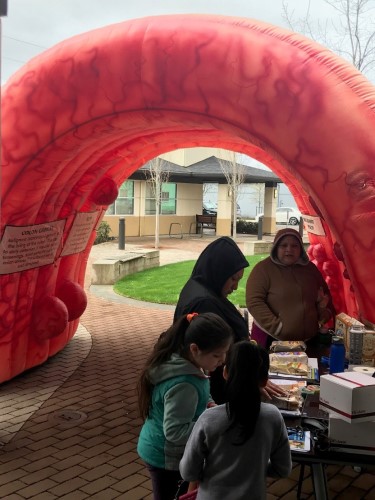
Originally beginning in 2011 as a research project, the Virginia Garcia Memorial Foundation and Health Center received a Tier 3 grant from the Community Partnership Program to use culturally appropriate outreach and education strategies in an effort to increase colorectal cancer (CRC) screenings among low-income Latinos/as receiving care at Virginia Garcia's community health centers.
Medical assistants and providers delivered educational materials about CRC screening to patients along with FIT kits and employed motivational interviewing techniques with age-eligible patients during clinic visits with all materials made available in English and Spanish. FIT kit instructions were wordless and contained pictures to help demonstrate proper specimen collection for all patients regardless of their level of literacy.
In March 2016, Virginia Garcia hosted two CRC screening awareness events in collaboration with the American Cancer Society. During these events, The Strollin' Colon, an interactive inflatable model of a colon, was set up to engage patients and clinic staff in learning the importance of CRC cancer screening and how to reduce risk for colorectal cancer. These events motivated Virginia Garcia's staff and patients to learn more about and discuss the importance of screening for colorectal cancer.
At project conclusion, Virginia Garcia increased CRC screening rates increased by 14% with a total of 5,532 participants. Person to person outreach was found to play a crucial role in both education and outreach as clinics that relied more heavily on direct mailings to contact patients eligible for screenings were less effective in increasing screening rates. The findings from this data imply that patients who discuss CRC screening with their providers during medical visits are more likely to screen for colorectal cancer. Engaging patients and having a staff member dedicated to patient follow up were also cited as crucial pieces of the project.
In Spring 2016, Virginia Garcia's Tier 3 grant was refunded with the goal of increasing Latino and uninsured colorectal cancer patient screening in clinics by at least five percent.
Special Call Grants
Step It Up! | Klamath Tribal Health & Family Services | Klamath County
In January 2016, the Community Partnership Program launched a special call for Tier 3 proposals focused on obesity prevention in Oregon communities. This funding provided special call grantees with support, specialized training and technical assistance to assist communities to implement and evaluate an evidence-based intervention based on tactics. One such tactic involved implementing physical activity in communities that would meet the Surgeon General's Step It Up! Call to Action.
Klamath Tribal Health & Family Services established walking groups in Klamath Falls, Bly and Chiloquin, to raise awareness of the benefits of physical activity as it relates to obesity and cancer and disease prevention. Each walking group was also complimented by social gatherings with an educational component. Informational brochures about diabetes and other chronic diseases with ties to cancer were also distributed to interested participants. These activities encouraged and empowered both tribal and non-tribal residents to make lifestyle changes for a healthier life.
Prior to the start of the program, Klamath's established a participation goal of fifty people in three locations across Klamath County. A kick-off celebration drew over 350 participants with over sixty people participating in the weekly walking sessions across four locations. Interest in the walking groups has remained high after the conclusion of the original six week program—additional official walks are scheduled to begin in the Spring of 2017.
